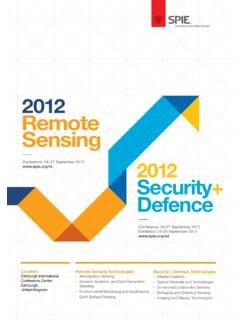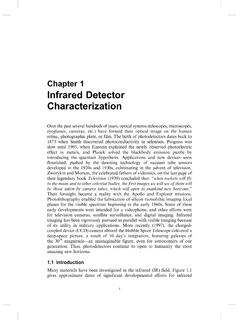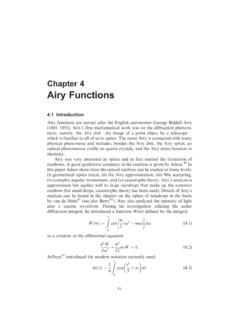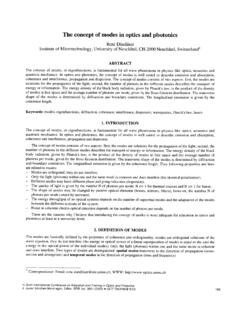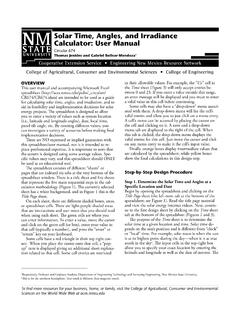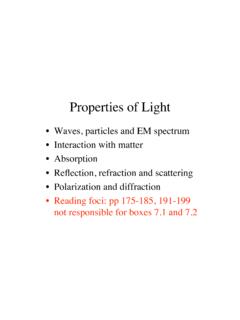Transcription of Flux and Irradiance flux irradiance intensity radiance
1 Basic Quantities in Illumination Flux and Irradiance 1In examining terminology for illumination, it is useful to separate the spatial considerations from the spectral concerns. In many cases, the spatial and spectral issues are independent and can be separated without losing any generality. In other cases, the spatial and spectral issues cannot be separated physically, but it is useful to separate them conceptually. The commonly used spatial quantities are flux, Irradiance , intensity , and radiance . Flux, , is the optical power or rate of flow of radiant energy. Irradiance , E, is the flux per unit area striking a surface.
2 Occasionally, the flux per unit area leaving a surface, called exitance, M, is important. However, the geometry is the same as for Irradiance , so it will not be treated separately here. Furthermore, when exitance is used, it is often the flux leaving a nonphysical surface such as the exit port of an integrating sphere or the real image in an imaging system, where it is identical to the Irradiance onto the surface. The Irradiance quantity itself says absolutely nothing about the directionality of the flux. For example, if the three cases in the figure below all have the same flux per unit area striking the surface, then they all have the same Irradiance .
3 Because of this ambiguity, specifications for illumination systems often qualify the Irradiance quantity with an added description of the desired directional properties. normal collimated illuminationoblique collimated illuminationdiffuse illumination Illumination Solid Angle 2 The definition of intensity involves the concept of a solid angle. A solid angle is a 3D angular volume that is defined analogously to the definition of a plane angle in two dimensions.
4 A plane angle, , made up of the lines from two points meeting at a vertex, is defined by the arc length of a circle subtended by the lines and by the radius of that circle, as shown below. The dimensionless unit of plane angle is the radian, with 2 radians in a full circle. A solid angle, , made up of all the lines from a closed curve meeting at a vertex, is defined by the surface area of a sphere subtended by the lines and by the radius of that sphere, as shown below. The dimensionless unit of solid angle is the steradian, with 4 steradians in a full sphere. area, a, on surface of sphere =a/r2(steradians) 4 steradians in a full sphere Closed curve r =l/r (radians) 2 radians in afullcircle rlBOA B O ABasic Quantities in Illumination intensity , radiance , and Projected Solid Angle 3 intensity , I, is the flux per unit solid angle.
5 It is the amount of flux from a point source contained in a small angular volume. A source can be considered a point source for this application if the Irradiance falls off as the inverse square of the distance from the source. intensity , for a given source, can vary with direction. radiance , L, applies to extended sources and surfaces. It is the flux per unit solid angle per unit projected area of the source or surface. The projected area is the projection of the area onto a surface normal to the direction of view and is equal to the actual area times the cosine of the angle between the surface normal and the direction of view.
6 radiance can vary with position on a surface, and like intensity , it can vary with direction. A source or surface with constant radiance in all directions is called Lambertian. A Lambertian source or surface has intensity that varies with the cosine of the angle with the surface normal. In many cases, the angle of view changes over the extent of the receiver. These cases require an alternate definition of radiance : radiance is the flux per unit area per unit projected solid angle. (In fact, this is the more general definition and covers the simpler case where the entire surface of the extended source is at essentially the same angle as the direction of view.)
7 The term intensity is used in many disciplines, some even closely related to optics, to mean things other than flux per unit solid angle. Use caution and rely on context to determine the meaning of the word in a particular situation. Illumination Solid Angle and Projected Solid Angle 4 The relationship between solid angle and projected solid angle can be confusing. Projected solid angle has meaning primarily for a small Lambertian source, which has intensity that varies as the cosine of the angle with the surface normal.
8 The projected solid angle, , is the solid angle, , weighted by the cosine of the angle with the surface normal. When the solid angle is large enough so that the angle with the surface normal is not the same over the entire solid angle, the total projected solid angle must be computed by integrating the incremental projected solid angles. See the reference by Bartell for a more detailed explanation. For some special cases, the integration results in simple expressions, such as for a large circular cone that is normal to a surface and subtends a half angle.
9 = sin2 A hemisphere has 2 steradians (solid angle) but projected steradians (projected solid angle). = cos Basic Quantities in Illumination Spectroradiometric and Radiometric Quantities 5In the spectral dimension of illumination, the most general view looks at the spectral density the amount of radiation per unit wavelength interval. In terms of the four spatial quantities already considered, the spectral quantities are spectral flux, ; spectral Irradiance , E ; spectral intensity , I ; and spectral radiance , L . These quantities, usually written with a subscript to indicate that they are integrable, must be integrated to determine the amount of radiation in a particular spectral band.
10 For example, the total radiant flux, (in units of watts), in the band between wavelength 1 and wavelength 2 is 21(1, 2)( ).d = Similar expressions can be written for the total Irradiance , E (watts/m2); total radiant intensity , I (watts/ sr); and total radiance , L (watts/m2 sr). Photometry measures the response of the human eye to light. Although not everyone has exactly the same response, the standardized CIE 1924 luminous efficiency function works very well for most people. (The CIE is the International Commission on Illumination.)


